
Scala at work on Ethereal. Photo: Dan Scala.
by BRONAĊ FERRAN
In mid-May, two different projects, one in London and one in Los Angeles, announced on social media that they were interconnecting glass and non-fungible tokens (NFTs). This called to mind the curator Anna Condo’s recent description of the present as the “Glass Age”. Condo is a successful photographer, and her curatorial approach to the NFT arena, also made visible in May this year, reveals a subtle awareness of the effects of luminosity and shade often missing from digital platforms, choosing works that bring a relative degree of visual stillness into the consistently decentring streams of optical stimulations. The timing of the glass and NFT announcements coincided, moreover, with the much-cited fall in the value of cryptocurrencies that has conveyed the financial risk and instability inherent in the idea of collecting crypto-art practices. Accordingly, artists are exploring new modes of offering works to collectors that take creative credence of these volatilities.
For the Los Angeles-based artist Kyle McDonald, progenitor of one of the two projects, an explicit objective has been to heighten awareness of the environmental cost of the current way of working of the three main cryptocurrency platforms that display NFTs.In part realisation of this impulse, McDonald has worked with an artist-craftsperson in California, resulting in three glass cubes containing environmentally related materials. Pursuing a provocative course of artistic intervention, McDonald is “selling three sculptures for a total of $17m+ to pay for 745,000+ tons of carbon offsets”, which he will then donate to environmental causes. That, paradoxically, working with glass is also a highly energy intensive medium is not yet mentioned in the promotional materials circulated by McDonald to his numerous followers on social media.
,-Anthony-Scala-x2.jpg)
Ethereal (2021-2022), Anthony Scala. Lit and unlit versions. Photo: Agata Pec.
The second of the two projects, which was created in London by the glass artist Anthony Scala and a cryptocurrency investor, George Renshaw, is integrally connected to the ethereum currency (which describes itself as a social technology). Renshaw, a trader in this area, observing how there were (like him) a growing number of collectors within the technological arena who were keen to show off their acquisitions, saw the potential to commission Scala, a studio glass-maker (whose geometrically based pieces he had seen and very much admired) to reflect somehow in material form the dematerialised, intangible nature of everyday online crypto transactions. The concept that he put to Scala was to recreate in glass the shape of the ethereum logo, leading to a dialogue over months last year during which Scala convinced Renshaw that what was aesthetically demanded was a transference from a two-dimensional flat surface to a three-dimensional object. They also both agreed to go beyond the concept of commissioning, to work together in partnership, resulting in Ethereal, the world’s first glass-related NFT. This they minted in February, having outlined the various steps in the work’s physical making at the website: kyba.squarespace.com/behindthescenes. The work has not yet been offered for sale directly but will be shown later in year in physical and digital formats at NFT art fairs, including in Madrid this October.
In their first interview together, Renshaw and Scala spoke to Studio International about the project’s genesis and the process of its development.
Bronaċ Ferran: George, I understand that the initial idea for doing something material with the ethereum logo came from you. What was the root of the concept?
George Renshaw: I saw some of Anthony’s works, from his “crystalline” series and was mesmerised and inspired because the works looked organic, like gemstones, but they were manmade by him. I thought they were truly remarkable. That is exactly what I wanted the ethereum real life sculpture to be. I wanted it to look like a gemstone that had been mined out of a deep cave in Antarctica or wherever. That is what I think he then actually created. I had already come up with the idea of doing something in material form that complemented the dematerialised, intangible nature of my everyday work in crypto-finance and yet somehow related to this.
-Anthony-Scala.jpg)
Counter Point, 2012. Anthony Scala. Photo: Ester Segarra.
BF: Can you say something about the timing of the work? It seems to fit seamlessly with a specific moment in time.
GR: It is important to say that last year was the “bull-run” for crypto in a cycle that, in fact, does happen every four years, 2013, 2017, 2021-22. The reason the crypto cycle works in that way is that the “bitcoin hash rate” halves every four years or so; the “hash rate” is that of the miners who are mining bitcoin. There will never be more than 21m bitcoins in circulation. That is how it was coded. Right now, there are about 19m in circulation. By the year 2140, all bitcoin will have been mined. That is the estimate. So, the halving that happens every four years brings a supply shock that kickstarts the crypto cycle, which not a lot of people know, although it is information that is readily available. In fact, stripping back the layers of the surface, there is so much behind each cryptocurrency and the crypto market in general. I guess what I wanted to see in the work that was commissioned was a revealing of those layers, making it all much more transparent.
For me, also, it was about pride in a new technology that has emerged within the last 10-15 years and that is pushing our society. Take the Ukraine crisis: $55m was donated through cryptocurrency in one week as it turned out to be the easiest and fastest way to give aid to people. Also, look at what is taking place in Ethiopia, where cryptocurrencies are being introduced to bank the previously unbanked.
BF: What is your response to hearing that another work in glass linked to NFTs is also now in development? How do you respond to its alternative, environmentalist, focus?
GR: Kyle’s creating this piece on the whole environmental impact of crypto-currency is really interesting; that is exactly an example of what happens when you strip back the layers to look underneath the surface of what is happening.
Obviously, the environmental impact is there, and it is very large at the moment. But it is worth also remembering that this is a very new technology, only created in 2008, so just over a decade ago. For about 10 years, no one knew about it so it is super-new. A lot of these cryptocurrencies, including ethereum, are “proof of work”, which requires many people “mining” at the same time and thus uses up a lot of energy. The founders of ethereum have now confirmed that they will move to “proof of stake”, which involves only one person becoming the lead miner, reducing carbon emissions by 99%. But the question is how fast they can do this, which is part of the question posed by Kyle’s project. So, just to say this again, this is a new technology, and they are evolving as quickly as they can really. Proof of stake is definitely the way to go in future.
BF: Turning to you, Anthony, how did you go about making this work? Also, why did you want to do it in the first place?
Anthony Scala: Like any project that I take on, I go from conceptual stages into a process of doing lots of tests. If you want it to be good using glass as a material, you really can’t cut corners. Cold-glass working is a very intensive and precise process.
At the same time, there was a sense of urgency, a sense that this has not been done before. When George invited me to get involved, I felt it fitted closely with my own sense of coming out of lockdown and a sense that things were changing around us over the last couple of years. Actually, for everybody I know, lockdown was the great resetter, whether positive or negative, it gave them an opportunity to step outside this crazy, hectic world – living in London – and a chance to reflect on “Why I was doing that” and to change the things they did not like. While it was terrible in so many ways, it shook off the shackles of the old system. I also managed to buy, from Italy, just before Brexit tariffs were imposed, a piece of equipment that allowed me to transform the working possibilities of my studio.
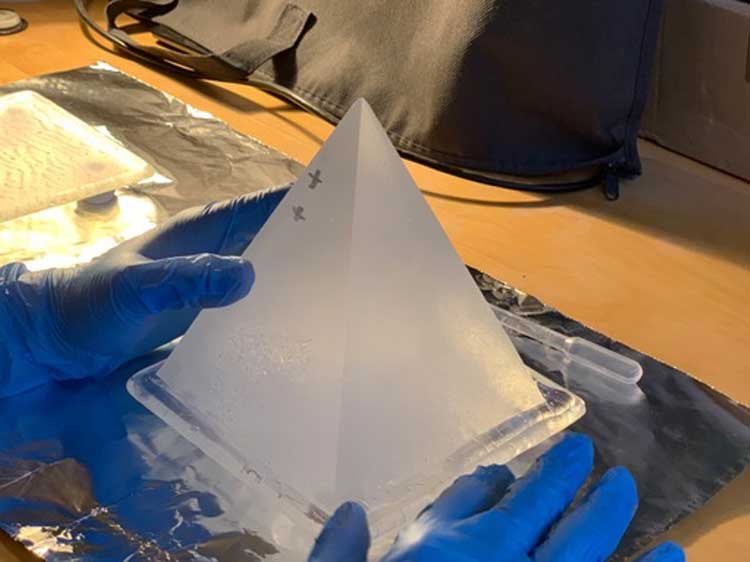
Scala at work on Ethereal. Photo: Dan Scala.
Because I had distanced myself from my old way of working, I was looking at exploring new ideas, so this came at a most fortuitous time. Not only did this give me an excuse to push my work in a different direction, but it brought me into a style of work that I had always been interested in, I mean digital work and collaborations that are always of interest to me.
BF: The basic form of transference that you have achieved in this instance is from a flat surface to a material form in space. You also seem to have achieved an effect of symbolic instantiation of an exchange between the mutability of glass and the hypernetworked transference of data through fibre optic networks. How did you achieve these effects?
AS: As sculptors, we always take a two-dimensional sketch and figure out a way in our heads to render it in 3D space. When I saw the ethereum logo, straightaway I knew what that was or could be in 3D space. It was almost instant. I saw it as twin four-sided pyramids hovering above each other. I knew it didn’t have to look exactly like the real thing. I wanted it to become more and more abstract. There were many time-consuming and highly physical stages involved in its making, including the use of ceramic refractory moulds to cast the glass. That took 10 full days to complete and reached a maximum temperature of 890C (1,634F). It then needed very careful cooling before the moulds were broken apart to reveal the glass pyramids within. The polishing of the surface then took over 100 hours. The title we gave to the work, Ethereal, is reflective of the qualities we wanted to achieve in both physical and digital formats.
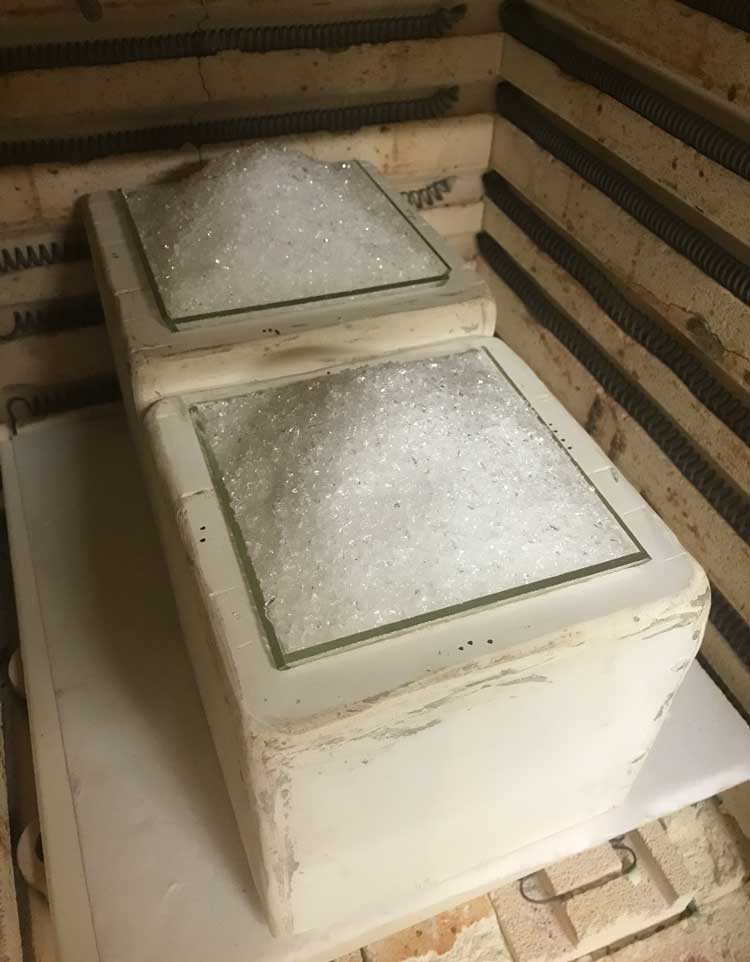
Ceramic refractory moulds used to cast the glass. Photo: Anthony Scala.
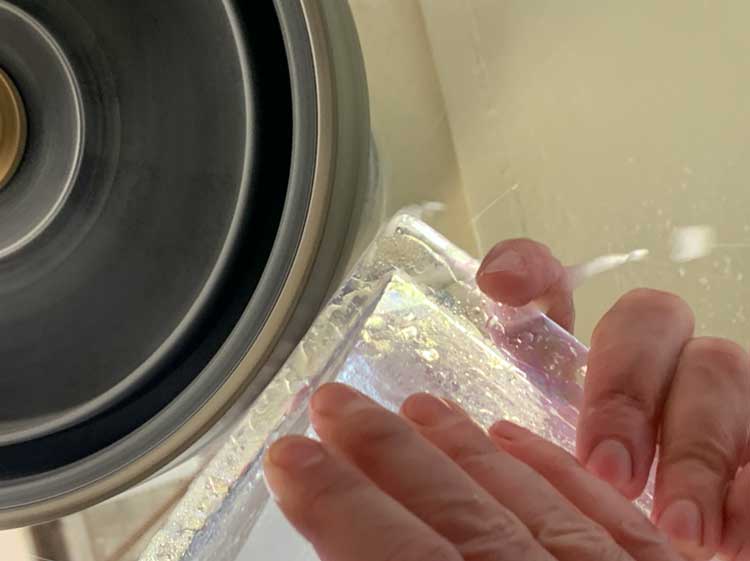
Scala at work on Ethereal. Photo: Dan Scala.
It’s worth sharing that in the beginning George had quite fixed ideas of what he wanted. I had quite fixed ideas of what I wanted. It was really quite difficult to get across to each other what we wanted. It was a process during which I was thinking: “How can I politely say, ‘No, we are not going to do this.’” That is the thing. That is where the dialogue came in. Also, doing some real drawings and development of models really helped us to get it into our heads what we were trying to create here.
Then the piece itself surprised both of us. Because I designed it to do a certain thing and then it didn’t do that at all. But it did something completely different.
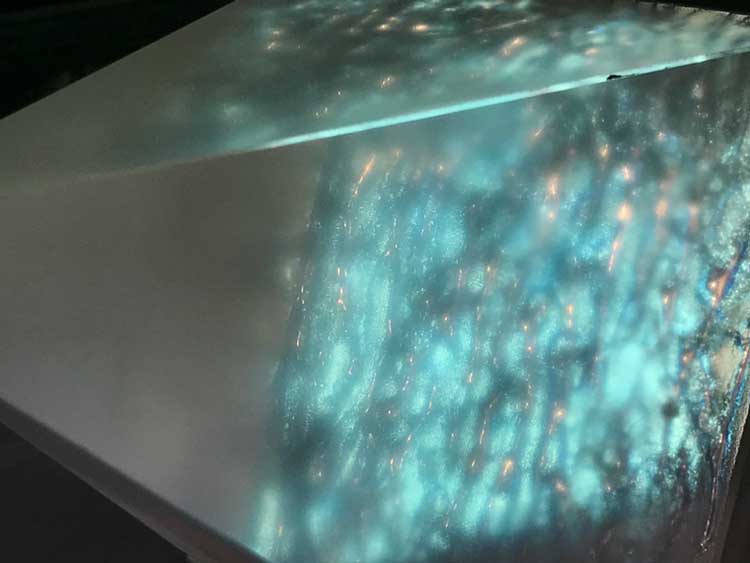
Lit image of Ethereal. Photo: Agata Pec.
That was connected to the effervescence present on the inside linked to the inclusion of hundreds of thousands of micro-bubbles that came into visibility when we projected laser light on it, all those pulsations of light moving through it. With glass, you have got to utilise material qualities. Part of this when working specifically with glass is to utilise the bubbles that form in the texture of the glass. So, these become part of the piece but that takes time to be fully recognised. In this instance, because I also had a polychromatic layer on the bottom, that was supposed to reflect something similar to this, when we projected light on it, a sort of 3D matrix just exploded in movement. I didn’t know that was going to happen at all.
That is why we do what we do. It is to have those moments of unpredictable outcomes. I wish I could say I had planned it, but it was nature and physics that did that, leading to something that I like my work to tap into, but that I could never create myself.
GR: When the work was ready, we decided to light it up using lasers, we shot this blue beam to the side, it created this V wall behind the piece and we were like, “Gosh, what is going to happen” and it caught the piece and it just exploded across the whole hangar where we were filming. I think the sense of movement was what was so phenomenal.
BF: Anthony, George has spoken of the pride that people he knows working in the crypto space are taking in showing off works that they are newly collecting. Is this different from how you usually engage with collectors?
AS: In my entire professional life so far, I have been absorbed in the model of focusing almost 100% on creating works for clients who will, in what might be termed “their scarcity obsession”, want to keep it to themselves, which is wonderful for them. Relatively, though, for the maker or craftsperson such pride and secrecy is not so good, as very few people get to see what they might have made and, of course, you need to get the work out there to get more commissions. In fact, something of the same thing happened here where, at first, we minted it but did not really tell anyone and then we realised this is the world’s first glass-based NFT so it is worth getting it out there into the world. I would like to invite people to really think about it, and how it mirrors a shifting period in which we have been living during which I think there has been a profound effect on collective consciousness on various levels.
BF: We have spoken before about the under-recognised capacity of glass as a site of memory storage. It is such an interesting topic given the focus that is intrinsic to blockchain systems on the notion of making a record, or a ledger of transactions, that is meant to be immutable. You were telling me about ancient Egyptian glass and how it has preserved properties over many thousands of years. Do you think this is something that deserves more attention?
AS: Absolutely. In terms of information storage and how this compares to the digital side of things, because glass is almost completely inert, you can store images in it that will be preserved for millennia. For example, you can sandwich photographic imagery into a block and that photograph will continue to look like that over 1,000 years, so in terms of the 21st and even 22nd centuries, when it comes to storage, we haven’t even begun to scratch the surface of glass’s potential as a site of encoding and preserving data for a time when our civilisation is not around any more. Once the information is placed in glass, it will happily sit there for tens of thousands of years.
BF: In making Ethereal and other works, you have become known for your exceptional style of using “polychromatic and dichroic” glass. Why are you drawn to these effects?
AS: Dichroic and polychromatic glass both exemplify a shifting of colours depending on perspective; the first involves a 2D colour shifting layer on the surface of flat glass while polychromatic glass fully colour shifts in three dimensions. Both embody how glass itself is a material and a medium that always seems to be in a state of flux, being constantly reinvented, modified and improved on with the rise and fall of each human empire. Actually, dichroic effects can be viewed in Roman glass from the fourth century. Later, it was developed as a specialised coating for precision lenses, mirrors and interference filters for laboratory use. Shifts in perception, refraction and optical illusion have always been at the very core of my work, so to find materials which naturally embody these properties was a gift.
On our website, we refer to how our view of Ethereal shifts depending on the angle of vision and on the frequency of light that hits it and link this to how blockchains are similarly distributed in various places at once.
Using dichroic glass enables me also to explore my long-term interest in physics and, in particular, quantum physics. How the indeterminacies of the subatomic can drastically alter our understanding of what is “real”, or in many cases “real” and “unreal” simultaneously has always been a special interest of mine.
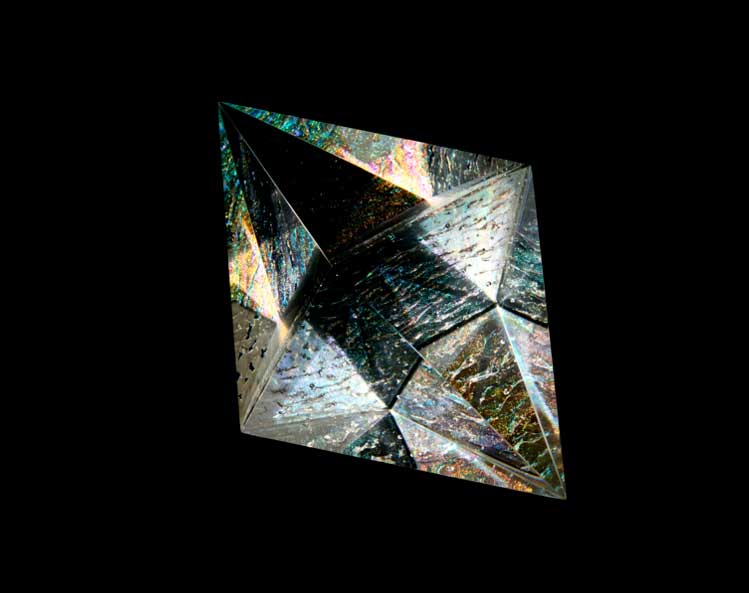
From Abstract Geometry series, 2021, Anthony Scala. Image: Agata Pec.
Through the use of such effects, I try to create work that in some small way reflects the indeterminacy of our perceived “reality”. That is my nod to the future, with a material which has transcended the ages. I have this concept in my mind of exploring through glass what I have termed “virtual ghost kinetics”; basically, this relates to the idea of having a physical structure that moves in one direction and creating an image within that structure that moves in a way that is independent. I am not yet wholly sure how I might do this, but I suppose in some ways it is a cryptic term for everything that might be possible to do in glass that hasn’t yet been fully realised.
,-Anthony-Scala-image-credit-Agata-Pec-3.jpg)
From Abstract Geometry series, 2021, Anthony Scala. Image: Agata Pec.
• Ethereal will be on show in physical and digital forms at CryptoArt Island NFT fairs later this year. Its next physical showing will be in Madrid in October.